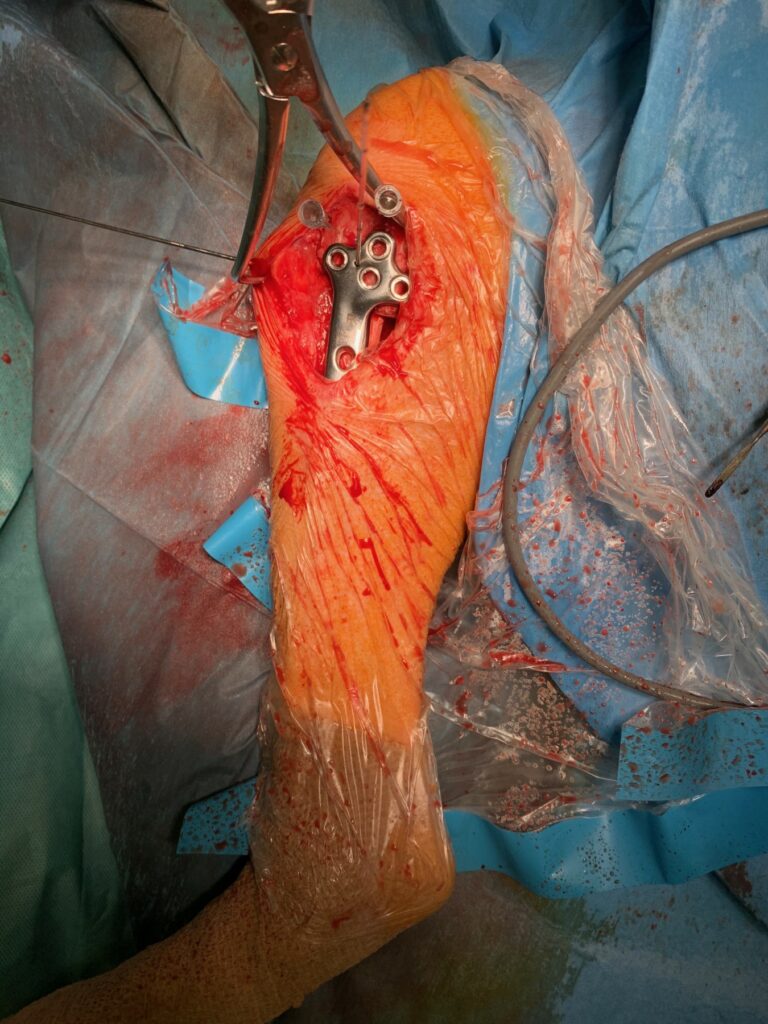
Hnízdo J., Pomahač O. TPLO u psů s hmotností nad 50 kg – aplikace nového implantátu u prvních 50 pacientů. TPLO in dogs above 50 kg – application of a new implant in the first 50 patients. Veterinární klinika 2021;18(5):213-224.
SOUHRN
Nový typ TPLO implantátu pro velká a obří plemena byl aplikován u 50 psů (58 kloubů) s kompletní nebo parciální rupturou CCL. Zahrnuti byli psi od 50 do 91 kg hmotnosti. Předoperační TPA byl v rozmezí 19-28°. U tří pacientů byla pomocí modifikované osteotomie provedena současně korekce excesivního valgu tibie. Průměrný pooperační úhel tibiálního plató byl 5°. Celkem nebylo dosaženo plánovaného sklonu ve 12 %. Ve třech případech byl zjištěn rock-back fenomén v akceptovatelném rozsahu do 12°. U žádného pacienta nedošlo k selhání implantátu a to bez ohledu na počet mono kortikálních šroubů v distálním segmentu kosti. Částečné přemostění osteotomie bylo 6. týden po zákroku rentgenologicky zjištěno u 57 operovaných kloubů. U dvou kolenních kloubů došlo během osteotomie k signifikantnímu krvácení popliteální arterie. U šesti kolenních kloubů byla obtížná kompletní rotace proximálního segmentu. Ve čtyřech případech byla zjištěna pooperačně infekce (surgical site infection =SSI), pouze u jednoho pacienta byla indikovaná explantace. Celkový počet klinicky relevantních pooperačních komplikací byl 18 %, SSI 7 %. Žádná z komplikací nebyla katast rofální, pouze v jednom případě byla indikována explantace. Tři měsíce po zákroku vykazovalo 46 pacientů (92 %) funkci končetiny, která byla nerozlišitelná od normálu. Autoři konstatují, že je TPLO s použitím nového implantátu u psů nad 50 kg hmotnosti úspěšnou metodou stabilizace a procento komplikací je nižší, než bylo dosud uvedeno v literatuře.
SUMMARY
A new type of TPLO plate for giant breed dogs was applied to 50 patients (58 joints) with complete or partial rupture of CCL. Dogs from 50 to 91 kg BW were included. Preoperative TPA was in between 19-28 °. The mean postoperative tibial plateau angle was 5 °. Valgus correction of the proximal tibia was performed with double crescendic cut, medial closing wedge, in three cases. In total, the planned TPA was not achieved in 12% of cases. In three cases, a rock-back phenomenon was found in the acceptable range (up to 12 °). No patient had implant failure, regardless of the number of monocortical screws in the distal segment of the bone. Partial bridging of the osteotomy was detected radiologically in 57 operated joints at week six after the procedure. In two knee joints, there was significant bleeding form popliteal artery during the osteotomy. Complete rotation of the proximal segment was difficult in the six knee joints. In four cases, surgical site infection (SSI) was detected postoperatively, and only one patient was indicated for explantation. The total number of clinically relevant postoperative complications was 18%, SSI 7%. None of the complications were catastrophic, only in one case explantation was indicated. Three months after the procedure, 46 patients (92%) showed full limb function that was indistinguishable from normal. The authors conclude that with the use of this new implant in dogs over 50 kg BW TPLO is a reliable method of stabilization and the percentage of complications is lower than
previously reported in the literature.*